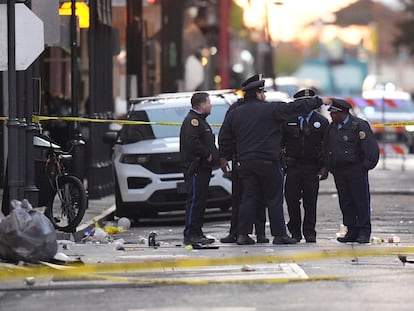Man who burned to death in Tesla outside Trump hotel identified as active-duty elite soldier
Authorities have announced that Matthew Livelsberger, a 37-year-old Green Beret, was the individual who rented and detonated an electric Cybertruck in Los Angeles

Matthew Livelsberger, a 37-year-old active duty member of the U.S. Army, was the man who burned to death inside the Tesla Cybertruck he had rented, which exploded in front of the Trump International Hotel in Las Vegas on Wednesday. His identity has been confirmed by official sources, according to the Associated Press. The FBI was investigating the incident as a premeditated act, with agents inspecting Livelsberger’s residence in Colorado Springs, Colorado, where he had driven for over 10 hours to carry out the act.
Livelsberger was a member of the U.S. Army’s Green Berets, an elite special forces group known for its guerrilla tactics. He joined the Army in 2006, receiving training at the renowned Fort Bragg (now Fort Liberty) in North Carolina, which specializes in anti-terrorism strategies.
Livelsberger was a member of the 10th Special Forces Group. He was in the United States on leave for the Christmas season. He was based in Germany, two Pentagon sources told The Wall Street Journal. He also served in Afghanistan, Tajikistan and the Congo. He was awarded a Bronze Star for combat merit and had shown no behavioral problems in his 19 years in the armed forces, both active and reserve.
By Wednesday night, more details about Livelsberger began to surface. FBI agents and reporters visited the Colorado Springs address he had used to rent the Tesla Cybertruck, an electric pickup truck produced by Elon Musk’s company, Tesla, via the Turo app.
Authorities were able to track the Cybertruck with assistance from Musk and several Tesla employees, who provided data on the charging stations Livelsberger used during his 745-mile journey, which spanned the state of Utah.
Las Vegas Sheriff Kevin McMahill said that Livelsberger entered the city shortly after 7:30 a.m. He drove around the main boulevard several times before heading to the Trump International Hotel, a 64-story tower located north of the Strip, the bustling area known for its casinos and hotels. Livelsberger parked in front of the hotel’s entrance for approximately 15 seconds, during which smoke began billowing from the Cybertruck. Moments later, the vehicle exploded.
On Wednesday, Sheriff McMahill presented photographs of the charred remains of the Cybertruck, known for its angular lines and futuristic design. He noted that the vehicle’s unique construction likely mitigated the force of the explosion, preventing significant damage to the Trump International Hotel. The blast did not even shatter the hotel’s windows, despite the vehicle being parked just a few feet from the lobby.
Authorities released images revealing that the back of the Cybertruck was packed with gasoline canisters and fireworks mortars. The explosion produced bursts of colored fire, which were captured by the security cameras of the Trump International Hotel.
Speculation arose on Wednesday afternoon that the Cybertruck explosion might be connected to the New Orleans attack during New Year’s Day celebrations, which left 14 people dead. That attack was carried out by Shamsud-Din Jabbar, a 42-year-old Army veteran who had also trained at Fort Bragg. However, military sources told the AP that Jabbar and Livelsberger did not overlap at the base. For now, the FBI has ruled out any connection between the two incidents.
Sign up for our weekly newsletter to get more English-language news coverage from EL PAÍS USA Edition
Tu suscripción se está usando en otro dispositivo
¿Quieres añadir otro usuario a tu suscripción?
Si continúas leyendo en este dispositivo, no se podrá leer en el otro.
FlechaTu suscripción se está usando en otro dispositivo y solo puedes acceder a EL PAÍS desde un dispositivo a la vez.
Si quieres compartir tu cuenta, cambia tu suscripción a la modalidad Premium, así podrás añadir otro usuario. Cada uno accederá con su propia cuenta de email, lo que os permitirá personalizar vuestra experiencia en EL PAÍS.
¿Tienes una suscripción de empresa? Accede aquí para contratar más cuentas.
En el caso de no saber quién está usando tu cuenta, te recomendamos cambiar tu contraseña aquí.
Si decides continuar compartiendo tu cuenta, este mensaje se mostrará en tu dispositivo y en el de la otra persona que está usando tu cuenta de forma indefinida, afectando a tu experiencia de lectura. Puedes consultar aquí los términos y condiciones de la suscripción digital.
More information
Archived In
Últimas noticias
The metaverse, four years later: Is it finished or just at a standstill?
$3,000 and a plane ticket: The United States increases incentives for migrants to self-deport before the end of the year
Charles Dubouloz, mountaineering star, retires at 36 with a farewell tour inspired by Walter Bonatti
From the White House to diplomatic gifts: Lego wins over adult fans, brick by brick
Most viewed
- The low-cost creative revolution: How technology is making art accessible to everyone
- Christian Louboutin: ‘Young people don’t want to be like their parents. And if their parents wear sneakers, they’re going to look for something else’
- All the effects of gentrification in one corner of Mexico’s Colonia Roma
- Christmas loses its festive spirit: ICE fears cast shadow over religious celebrations
- Liset Menéndez de la Prida, neuroscientist: ‘It’s not normal to constantly seek pleasure; it’s important to be bored, to be calm’










































